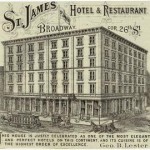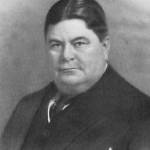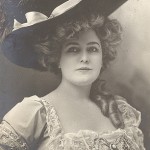Dr. Herman Livingston Collyer, a successful gynecologist, his wife Susie, and their sons Homer and Langley moved from Murray Hill to 2078 Fifth Avenue, at 128 Street, in 1909. The house was a three-story brownstone mansion, with mahogany paneling, fine antiques, and family portraits dating to the eighteenth century. The Collyers were among New York’s oldest families. Their ancestors came to America on the Speedwell, which, according to Langley Collyer, “…had a better passenger list than the Mayflower.”
Two years after the Collyers’ arrival, African-Americans began settling in Harlem in large numbers. By 1925, Harlem had been transformed from an upper-middle-class white suburb into the center of African-American life.
But while nearly all the other white folks left, the Collyers did not. Dr. Collyer died in 1923, Mrs. Collyer in 1929. Their sons remained in the mansion. According to Trinity Church’s baptismal records, Homer Collyer was born on November 6, 1881. Langley was about six years younger. Both men graduated from Columbia: Homer, who graduated with the class of 1904, earned an MA, an LLB, and an LLM and practiced admiralty law. Langley took his degree in chemistry and mechanical engineering. He never worked for a living, devoting himself to music.
In 1928-’29, Homer worked in the law office of John McMullen, who would become the family lawyer. Homer then worked for City Title Insurance at 32 Broadway, spending his days researching in the Hall of Records. A former colleague described Homer as an affable, courtly, Dickensian type, with old-fashioned clothing, high collars, and elaborate sideburns who wrote with an elegant Spencerian hand.
Langley, who was last photographed in 1946, looked like a stereotype of an aging late Romantic poet, with an old-fashioned bow-tie, formal black jacket and vest, gray striped trousers, a long gray mustache, and longish hair.
By 1917, the Collyers’ telephone had been disconnected because, as Langley explained, they were “being billed for long distance calls they didn’t make.” In 1928, the gas was shut off. The brothers began going without steam heat and hot running water, using kerosene for lighting and cooking. The Encyclopedia of New York City and Jan Morris in Manhattan ’45 claim they had no water or sewer connection; no contemporary sources go that far. Some of the local kids threw stones through their windows and after Langley had spent large sums to replace the glass, he decided it was better to board them up and close the inner shutters.
Most sources agree that Homer last appeared in public in 1932. In 1933, he suffered a stroke, with “hemorrhages in both eyes,” and went blind. Thereafter, Langley cared for him. They avoided doctors, treating Homer’s illnesses with special diet and rest. Langley said Homer ate 100 oranges a week and treated his eyes by consciously resting them: keeping them closed at all times.
Their solitude was first violated by the press on August 11, 1938, when Helen Worden wrote an article for the World-Telegram about Maurice Gruber, a real estate agent who wanted to buy Collyer property in Queens. When the Collyers did not respond to his letters and then his personal visits, Gruber staked out the house. By the following day, Worden found Charles Collyer, a distant cousin working as a ticket agent for the Long Island Rail Road, who suddenly and conveniently became worried that Homer was dead. Worden’s article was accompanied by photographs posing Charles Collyer and his wife on the front steps of the mansion. Worden called Langley “the mystery man of Harlem.” She recapitulated every street rumor that behind the shabby facade was a veritable Arabian Nights’ palace of Chinese rugs, rare antiques and thousands of morocco-bound books, including piles of money that Langley was afraid to put in the bank.
She then staked out the mansion herself. One night she caught Langley slipping out to go shopping and began her interview by calling out, “Good evening, Mr. Collyer. The neighbors tell me you keep a row boat in the attic and a Model T in the basement.”
Strangely enough, Langley responded. “Yes and no,” he replied. The boat, he explained, was his father’s canoe. “He used to carry it to the Harlem River on his head and paddle down to [Bellevue] every morning and back every evening. The auto was his, too. I never got around to putting it together again after he died.”
Langley later claimed all his troubles dated from these articles. Jan Morris writes that “…nobody ever interfered with them it seems, or tried to make them live like everyone else. They were the Collyer Brothers, Harlem’s Most Fascinating Mystery, as the tabloids like to say, and fashionably mysterious they were allowed to remain.”
But they were not left alone. As the Daily News wrote, “folks attempted to see for themselves.” This phrase is ambiguous. The clippings on the Collyers leave a strong impression that from the late thirties, nosy neighbors knocked on the door, nasty kids threw rocks at the house, broke their fence, and smashed bottles in their front yard, and reporters kept interviewing obscure relatives on the steps of the house, expressing concern over poor cousins Homer and Langley.
Another story quoted a neighbor describing Langley as “the ghosty man… He did have a brother, Homer, but nobody’s seen him in a long while. They ain’t seen his ma, either. She was s’pose to be dead, but she never had a funeral… He’s like haunts in graveyards, he don’ come out before midnight.”
Langley panicked. Though gloomy, the house had not been messy in 1938. By 1942, Langley had single-handedly accumulated vast quantities of newspaper, cartons, tin cans and other refuse, transforming the mansion into a fortress. He apparently applied his engineer’s training to arrange packing boxes and cartons in interlocking tiers with concealed tunnels passing from one room or one floor to another. Langley alone was familiar with the maze. Anyone else would have to remove the entire barricade to pass. He also booby-trapped massive piles of newspapers and old luggage with trip wires.
Their final drama began at 8:53 a.m. on March 21, 1947, when a man who gave his name as Charles Smith telephoned police headquarters, saying, “There was a dead man in the house at 2078 Fifth Avenue.” Police arrived around 10 a.m. to find a crowd of Harlem residents outside the house. The police roped off the area. Some officers tried forcing the mahogany front doors. Then the police took them off their hinges. There stood a solid wall of boxes and debris, up to the ceiling.
Other officers entered the unlit, cluttered basement. The way from the basement to the first floor was blocked by a solid mass of packing cases. Then, the police forced the shutters on a first floor window. Within lay a desolation of ceiling-high stacks of boxes, paper, and furniture, crawling with rats. The officers found the stairs to the second floor blocked with yet another mass of packing cases.
Two hours after the police first arrived on the scene, officers finally clambered from a ladder into a second-story room. There they found Homer dead. He was emaciated, bearded (Daily News) or mustachioed (Times), clothed only in either a tattered robe (Times) or a few ragged fragments of clothing (The Sun), and lay with his knees drawn almost to his chin. Dr. Thomas Gonzales, the medical examiner, said that Homer’s body was extremely emaciated and dehydrated. “There is no question,” Gonzales said, “that he had been neglected for a long time.” There was no food in his stomach or his digestive tract, indicating he had nothing to eat or drink for at least three days before his death, which was attributed to chronic bronchitis, gangrenous decubital ulcer (a large, untreated bedsore), and senile pulmonary emphysema.
The story was a wild sensation: on March 22, 1947, even the Times printed a front-page story on Homer’s death. By the end of the second day, according to the Times, the police had removed nineteen tons of debris from the first-floor hallway alone.
As the search for Langley continued, thousands of curious citizens walked or drove by the house. According to the Daily News, “few lingered at the scene. They were driven away by the smells.”
A friend whose father covered the story for one of the dailies told me the cops lit up cheap, foul-smelling cigars against the overpowering stench of organic corruption—”like a blow from a mailed fist.” For not only the newspapers, garbage, and animal wastes were rotting, but as a city housing inspector told The Sun, even the house was rotting: Its floor and walls were saturated because of the open windows and roof leaks, the beams were rotted and buckled from the weight of the junk and bricks were falling from the walls.
The New York County public administrator, a Surrogate’s Court official, took over the search from the police. On March 31, the public administrator hired six professional movers to remove all articles of value from the house. They tore out the basement entrance and began emptying the law library. The 2500 law books were merely a tenth of the volumes in the house. They found numerous family oil portraits. They found Mrs. Collyer’s hope chests, jammed with unused piece goods, silks, wool, damask, and brocade; three bolts of embroidered white curtain material, each containing 54 yards, that had never been unwrapped; and a batch of fine linen dish towels, stamped “Collyer,” that had never been used.
They found telephone directories, three revolvers, two rifles, a shotgun, ammunition, a bayonet and a saber, a half-dozen toy trains, toy tops, a toy airplane, fourteen upright and grand pianos, cornets, bugles, an accordion, a trombone, a banjo; tin cans, chandeliers, tapestries, a portrait camera, enlarger, lenses and tripods, a bowling ball in a canvas bag, bicycles and bicycle lamps, a rolled-up 100-foot rug runner, a nine-foot-tall mahogany clock with a music box inside and pastel painted figures on the broad face; thirteen ornate mantel clocks, including one contained in a metal bust of a girl whose ears and bodice dripped coins, thirteen Oriental rugs, heavily ornate Victorian oil lamps and vases, white plaster portrait busts, and picture frames. They found a static machine, an electrical device manufactured during the 1890s for the treatment of arthritis, rheumatism, and other ailments. They found five violins, at least two dating from the 18th century, two organs and scores of seven-inch gramophone records dating from 1898, including “Round Her Neck She Wears a Yeller Ribbon for her Lover Who is Fur, Fur Away,” “Atta Baby,” and “Nobody In Town Can Bake a Sweet Jelly Roll Like Mine.” They found sheets in braille from Homer’s failed attempts to learn the system. And they found a certificate of merit for punctuality and good conduct awarded to Langley at Public School 69, 125 West 54th St., for the week ending April 19, 1895.
These things merely salted the vast sea of junk and paper.
By April 3, according to the Herald Tribune, the searchers had removed 51 tons of waste. They had only reached two rooms on the first floor. By April 8, nineteen days after the search began, The Sun reported 103 tons of debris removed. Then they found Langley’s body.
He had been buried alive in one of his booby traps while crawling to bring Homer food. He had been only eight feet from his brother. He was wearing burlap draped over his shoulders as a cape, and police speculated this had snagged on a wire and tripped the booby trap. Langley wore no underwear or socks. He had on a bathrobe, three jackets, and four pairs of trousers. Around his neck as a scarf was a white onion sack fastened with a safety pin. He lay on his right side and the rats had been at him. Both The Sun of April 8 and the World-Telegram of April 9 stated that a preliminary examination indicated Langley had died quite some time before his brother. Apparently, Homer had died utterly, horribly alone.
On May 9, 1947, Robert F. Wagner Jr., the city’s commissioner of Housing and Buildings (later Manhattan borough president and mayor), announced the mansion would be demolished as unsafe and a menace to life and property. It was torn down within the year.
Langley was buried in the Collyer family plot in Cypress Hills Cemetery on April 11. The funeral arrangements were made by the public administrator’s office. The numerous relatives produced by the press apparently did little more than attend the services and file claims against the brothers’ estates.
There was no great wealth. The Surrogate’s Court probated the estates in 1949: $60,000 in real estate holdings, $2000 in savings, $4000 from the sale of personal property. Against this were claims for $15,000 in estate taxes and thousands more in city, federal, and state tax arrears. It is unclear whether the forty claimants against the estate ever saw a dime.
The only explanation Langley ever provided for the brothers’ behavior was that they preferred to live alone.
— New York Press, October 5, 1999
 Four years later, he began working for the New York Central Railroad. He studied bookkeeping and penmanship (he wrote a magnificently ornate hand and usually signed his name in full, deeming James Buchanan Brady a name worthy of a few flourishes).
Four years later, he began working for the New York Central Railroad. He studied bookkeeping and penmanship (he wrote a magnificently ornate hand and usually signed his name in full, deeming James Buchanan Brady a name worthy of a few flourishes).
 Yet Brady’s relationship with the most lusted-after woman in the United States—the blonde, blue-eyed, spectacularly voluptuous Lillian Russell—was entirely Platonic. America’s sex symbol during the 1880s and ’90s, Russell had made her mark as an actress and singer, but she was also a skillful card player and and an unerringly accurate tobacco spitter. Her extraordinarily warm, intimate friendship with Brady lasted for over thirty years. He was her frequent escort; they traveled and vacationed together; they confided in one another. She came to love him dearly. Sex, however, never entered into it.
Yet Brady’s relationship with the most lusted-after woman in the United States—the blonde, blue-eyed, spectacularly voluptuous Lillian Russell—was entirely Platonic. America’s sex symbol during the 1880s and ’90s, Russell had made her mark as an actress and singer, but she was also a skillful card player and and an unerringly accurate tobacco spitter. Her extraordinarily warm, intimate friendship with Brady lasted for over thirty years. He was her frequent escort; they traveled and vacationed together; they confided in one another. She came to love him dearly. Sex, however, never entered into it.